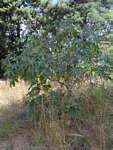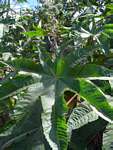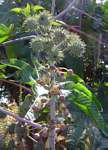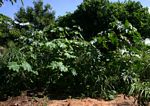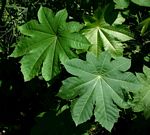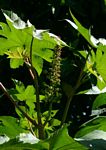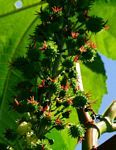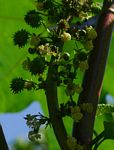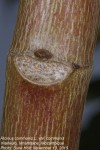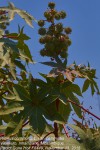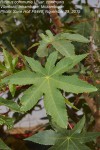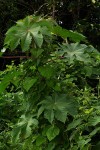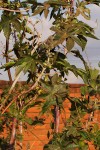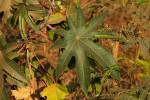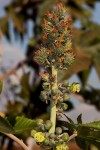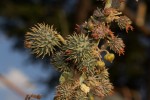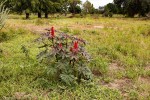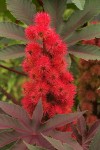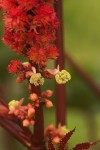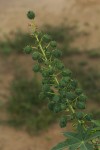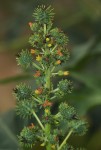Ricinus communis
communis
Selected images: Click on each image to see a larger version and details of the record View all images (28)
Detailed records: Display species records QDS maps by: Google Maps Point records by Google Maps
Species details: Click on each item to see an explanation of that item (Note: opens a new window)
| Synonyms: | |
| Common names: | Castor-oil plant (English) |
| Frequency: | |
| Status: | Introduced |
| Description: |
Robust, hairless annual or perennial herb, shrub or even small tree. Stipules united to form a sheath. Leaves alternate, peltate, palmately-lobed, the lobes with glandular teeth. Inflorescences paniculate; flowers unisexual in the same inflorescence; male flowers in lower half, female in upper. Male flowers with pedicels jointed, with 2 bracteoles; calyx with 3-5 lobes; petals and disk absent; stamens numerous. Female flowers with pedicels elongating in fruit; sepals 5; petals and disk absent; ovary 3-locular, each with one ovule; styles 3, dark red. Fruit 3-lobed, smooth or covered in spiny bristles, splitting into three 2-valved parts. Seeds smooth, mottled. |
| Type location: |
|
| Notes: | |
| Derivation of specific name: | |
| Habitat: | Cultivated and commonly naturalised, occurring in disturbed places, sandy river beds, forest edges and riverine vegetation. |
| Altitude range: (metres) | |
| Flowering time: | |
| Worldwide distribution: | Native of NE tropical Africa. Well naturalised throughout the tropics, subtropics and even temperate zones. |
| FZ divisions: | N,SW,SE |
| Growth form(s): | Tree, annual, perennial, shrub over 2 m, shrub under 2 m. |
| Endemic status: | |
| Red data list status: | |
| Insects associated with this species: | Achaea catella (Larval food plant) Micraphe lateritia (Larval foodplant) Eurytela dryope angulata (Larval foodplant) |
| Spot characters: | Display spot characters for this species |
| Literature: |
Baumann, G. (2005). Photographic Guide to Wildflowers of Malawi Wildlife and Environmental Society of Malawi Pages 72 - 73. (Includes a picture). Burrows, J.E. & Willis, C.K. (eds) (2005). Plants of the Nyika Plateau Southern African Botanical Diversity Network Report No. 31 SABONET, Pretoria Page 149. (Includes a picture). Burrows, J.E., Burrows, S.M., Lötter, M.C. & Schmidt, E. (2018). Trees and Shrubs Mozambique Publishing Print Matters (Pty), Cape Town. Page 466. As Ricinus communis (Includes a picture). Curtis, B.A. & Mannheimer, C.A. (2005). Tree Atlas of Namibia National Botanic Research Institute, Windhoek Page 638. Drummond, R.B. (1975). A list of trees, shrubs and woody climbers indigenous or naturalised in Rhodesia. Kirkia 10(1) Page 252. As Ricinus communis Heath, A. & Heath, R. (2009). Field Guide to the Plants of Northern Botswana including the Okavango Delta Kew Publishing Page 127. (Includes a picture). Mabberley, D.J. (1997). The Plant-Book. 2nd edition. Cambridge University Press, Cambridge Page 618. Mapaura, A. & Timberlake, J. (eds) (2004). A checklist of Zimbabwean vascular plants Southern African Botanical Diversity Network Report No. 33 Sabonet, Pretoria and Harare Page 41. Ntore, S. & al. (2024). Checklist of the vascular plants of Burundi Page 110. Parker, T. (2023). Common Trees of Mozambique The Tree Press, Austin, Texas, USA Pages 152 - 153. (Includes a picture). Pickering, H. & Roe, E. (2009). Wild Flowers of the Victoria Falls Area Helen Pickering, London Page 63. (Includes a picture). Radcliffe-Smith, A. (1996). Euphorbiaceae Flora Zambesiaca 9(4) Pages 157 - 159. (Includes a picture). Schmidt, E., Lötter, M. & McCleland, W. (2002). Trees and shrubs of Mpumalanga and Kruger National Park Jacana, Johannesburg, South Africa Pages 294 - 295. as Ricinus communis (Includes a picture). Setshogo, M.P. (2005). Preliminary checklist of the plants of Botswana. Sabonet Report no. 37. Sabonet, Pretoria and Gaborone Page 58. as Ricinus communis Timberlake, J.R. & Childes, S.L. (2004). Biodiversity of the Four Corners Area: Technical Reviews Volume Two (Chapter 5-15) Appendix 5-1: Plant Checklist Occasional Publications in Biodiversity 15 Page 208. Wild, H. (1955). Common Rhodesian Weeds Government of Rhodesia, Salisbury Page 49. as Ricinus communis (Includes a picture). |
Other sources of information about Ricinus communis var. communis:
Our websites:
Flora of Botswana: cultivated Ricinus communis var. communisFlora of Caprivi: Ricinus communis var. communis
Flora of Caprivi: cultivated Ricinus communis var. communis
Flora of Malawi: Ricinus communis var. communis
Flora of Malawi: cultivated Ricinus communis var. communis
Flora of Mozambique: Ricinus communis var. communis
Flora of Mozambique: cultivated Ricinus communis var. communis
Flora of Zambia: Ricinus communis var. communis
Flora of Zambia: cultivated Ricinus communis var. communis
Flora of Zimbabwe: Ricinus communis var. communis
Flora of Zimbabwe: cultivated Ricinus communis var. communis
External websites:
African Plants: A Photo Guide (Senckenberg): Ricinus communisAfrican Plant Database: Ricinus communis
BHL (Biodiversity Heritage Library): Ricinus communis
EOL (Encyclopedia of Life): Ricinus communis
GBIF (Global Biodiversity Information Facility): Ricinus communis
Google: Web - Images - Scholar
iNaturalist: Ricinus communis
IPNI (International Plant Names Index): Ricinus communis
JSTOR Plant Science: Ricinus communis
Mansfeld World Database of Agricultural and Horticultural Crops: Ricinus communis
Plants of the World Online: Ricinus communis
Tropicos: Ricinus communis
Wikipedia: Ricinus communis
